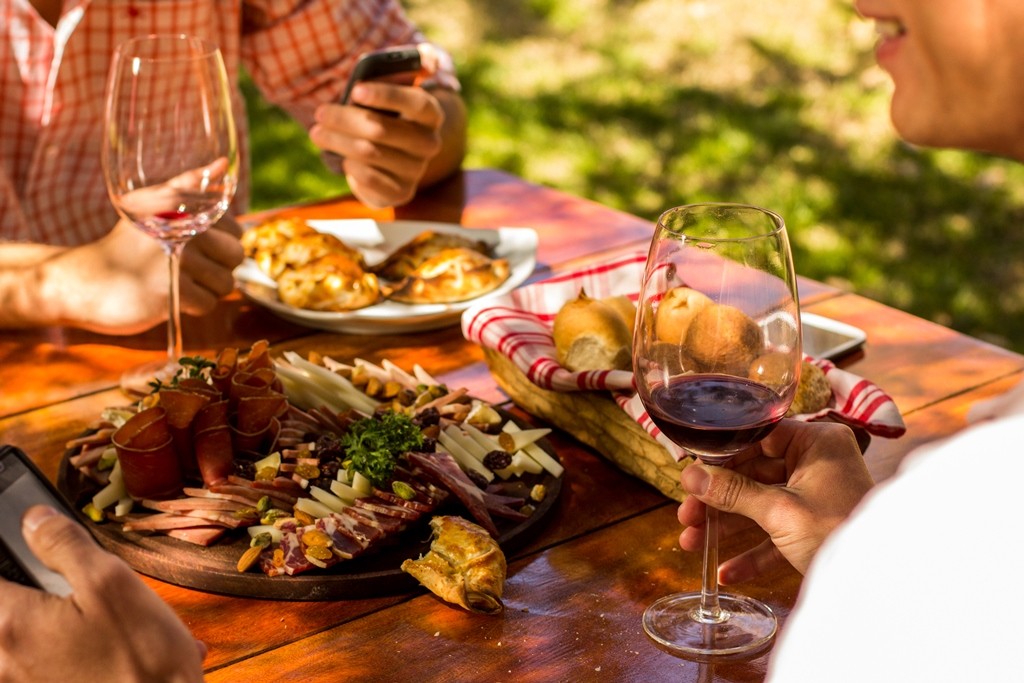For Argentines, a picada is a reason to meet. We have them in the garden, in the living room or a bar for something more substantial, with friends, talking and munching on a delicious snack.
But for anyone who has not had a picada in Argentina, there are three things to know. Firstly, it mustn´t be rushed, because it’s not only about the food but also the conversation. Secondly, on the table there will be all kinds of meats and cheeses. And thirdly, wine is very important, red, white or rosé.
As with Italian antipasti, Spanish tapas or Arab food, the trick with a picada is that you can put whatever you want on it, whenever you want and however much you want. Everything comes in small portions with no sauces, so no dirty hands. With everything ready, it is time to eat and everyone is happy, the conversation peaks here and there and the hours pass along pleasantly.
What makes a good picada?
All picadas have at least three kinds of cold meat. A good chorizo de campo made in some famous places, like Colonia Caroya, in the province of Cordoba, or Mercedes and Tandil, in Buenos Aires. The three regions are particular in their preparation, but offer different feather (strains of fungi on the skin) and seasoning. In any case, it resembles the Spanish chorizo, even if we consume it fresher and more tender. There is also diced mortadella and bondiola or prosciutto. The latter ones mark the level of the picada. If it is raw, which in our country is the Italian style (less curing), it equals a top notch picada.
As for cheese, the world’s your oyster. With so many new producers, the range of cheeses on offer is huge. We went from eating three basic types made with cow´s milk like gouda, gruyere and sardo, to a greater variety which now decorates the picada. For example, brie or camembert, that are softer than the French ones, but still smooth; Saint Julien and crottin with goats milk, and Manchego. A good trio of these cheeses will be chopped up and added.
Some classic antipasto finishes off the mix. You´ll always get a pot of olive oil for dipping bread, and some dried fruit, nuts, almonds and cashews. And the inevitable olives: black, Greek, sajadas or green and in varying sizes. Finally, some sun dried tomatoes are hydrated with vinegar and olive oil and a pickled eggplant, depending on individual taste.
Where can you eat them?
Well, it may take a couple of stops in various stores to gather all the ingredients. And while there are specialised places – La Tablita or Valenti in Buenos Aires, Torrent in the Mercado Central in Mendoza, to mention three of them – the truth is that preparing takes time and dedication.
Therefore, often what we do is order a ready-made one. And, as with sushi, you almost always choose by quantity of dishes and meats and cheeses. The upside of getting it out is that supply is often wider. The downside is you have to choose the right place for good quality products. Because when someone else is preparing it, some are excellent and some are not.
There are many good places to eat them in Buenos Aires. In Palermo, Lo de Jesus (Gurruchaga 1406), which has rich products and a remarkable collection of siphons on a high shelf. Also, Il Posto Mercato (Soler 5502), a charming place that also offers to deliver products they like. In La Boca, El Obrero (Agustin R. Caffarena 64) with top notch food and a pantry style from another time.
For those looking for a place in Mendoza there are a handful of places to go. Among the classics, Avenue Aristides Villanueva, which really gets going at night, offers many bars like El Palenque (Aristides Villanueva 287). On the outskirts of the city, Cavas de Cano, in Lujan de Cuyo (San Martin 2488), an old warehouse converted into a restaurant that offers quality and quantity. While in Valle de Uco, on the wine route, the legendary La Posada del Jamón is in Vista Flores (Route 92, km 13), where a family prepares and serves handmade quality deli.
With this comprehensive roadmap, only one thing is missing: wine. For Argentines, reds are king, and with a picada they usually prefer a soft, friendly Malbec. However, some are beginning to go more for rosé wines and whites, mainly Chardonnay, and other high altitude whites. The reason? The new freshness of these wines brings a spark to the picada and the conversation. In any case, one last thing: we recommend starting with sajadas olives, which are the first to be scoffed.



